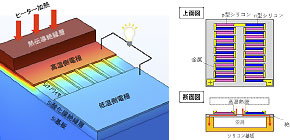
Novel micro thermoelectric generator to utilize thermal difference between environmental and body heats
Will open up a pathway to a permanent power source that supports IoT-based society
A group of researchers led by Junior Researcher Motohiro TOMITA and Professor Takanobu WATANABE at Waseda University, Associate Professor Yoshinari KAMAKURA at Osaka University, and Hiroya IKEDA at Shizuoka University, together with the National Institute of Advanced Industrial Science and Technology (AIST), developed a thermoelectric generator with a high power density that generates power utilizing body heat. This device uses the same technology to manufacture semiconductor integrated circuits (ICs).
In preparation for an IoT (Internet of Things)-based society where objects and people are interconnected through communication networks, technology to operate small sensor terminals through the use of power generated from micro energy sources in the environment is actively being developed.
When there is a temperature difference between the two materials, an electric current flows in the circuit. This phenomenon, called the ‘Seebeck effect,’ has been known since the 19th century. However, thermoelectric generation has lower power generation efficiency than photovoltaic generation, so the application of thermoelectric generation using the Seebeck effect was limited. In the 2000s, nanotechnology progressed rapidly and new materials to enable high power generation efficiency were developed.
Silicon nanowires used for semiconductor ICs can achieve high power generation efficiency. Currently, high power thermoelectric microgenerators that use technology for manufacturing silicon semiconductor ICs are being developed all over the world.
To generate high thermoelectric power by silicon nanowires, it is necessary to secure a large temperature difference inside the nanowires. For this reason, conventional silicon-based thermoelectric generators used long silicon nanowires, which were suspended on a cavity to cutoff the bypass of the heat current and secure the temperature difference across the silicon nanowires.
This silicon nanowire-based thermoelectric generator does not have a cavity structure. Instead, using shorter silicon nanowires, the generator improved its performance by controlling heat flux from the substrate surface to the back surface. As predicted by computer simulations, shorter nanowires improved the generator’s thermoelectric performance.
The structure of this device is simple and permits mass production using the same manufacturing technology with semiconductor ICs. The device can generate a high power density of more than 10 microwatts per 1cm 2 .
This power generator will enable autonomous operation of sensors and wireless communications utilizing environmental and body heats as energy sources. It is anticipated that this thermoelectric performance will support power technology in an IoT-based society.
Their research results were presented at the 2018 Symposia on VLSI Technology and Circuits which was held from June 18 through June 22 in Hawaii, USA.
Figure 1
Figure 2
Related links

